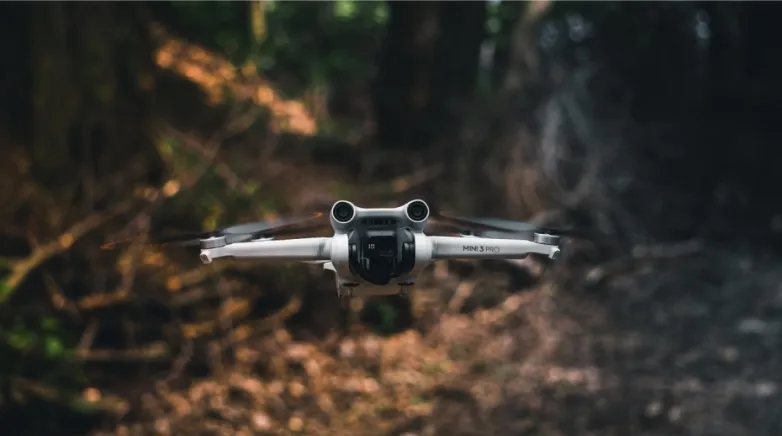Innovative Drone Solutions for Environmental Monitoring and Conservation

Curious to discover how drones are being used to save the planet?
The drone industry is booming. In 2024, the global drone market size hit $73 billion and is forecasted to surge to $163 billion by 2030.
Here's what you need to know…
Environmental non-profits around the world are utilizing drones to monitor wildlife populations, track deforestation rates, and safeguard endangered species like never before. The results? Unbelievable.
Here's the deal…
Traditional conservation methods are incredibly costly, dangerous, and frequently disturb the ecosystems they aim to protect.
Modern drone technology solutions are transforming everything.
Think about it. Thermal imaging that detects polar bear dens buried under Arctic snow… multispectral sensors that pinpoint illegal logging deep in the heart of remote rainforests… american-made drones are leading the charge in conservation efforts across the globe.
What you'll discover:
-
How Drones Are Saving Endangered Species
-
The Tech Behind Environmental Monitoring Systems
-
Cost-Effective Solutions That Actually Work
-
Real-World Success Stories You Need to Know
-
How to Get Started With Conservation Drone Programs
How Drones Are Saving Endangered Species
Researchers are now able to accurately count wildlife populations with a 96% success rate using drones. That's 70% higher accuracy than the old-school ground-based methods!
Here's why this matters:
Traditional wildlife monitoring requires boots-on-the-ground (or should we say boots-on-the-beach?) teams of researchers to physically enter animal habitats. This process stresses out the animals, messes with their natural behaviors, and puts human lives at risk.
Drone technology solves all of these problems at once.
Take polar bear research in the Arctic, for example. Scientists used to hire ridiculously expensive helicopters to fly over and search for den sites in the snow. But finding a one-meter-wide cavity in an endless sea of white? Practically impossible.
Now they're using thermal imaging drones that can spot bear dens based on their 10-15°C higher temperature than the surrounding snow. The bears remain undisturbed, researchers stay safe and warm, and the data quality is off the charts.
Pretty cool, right?
The Technology Behind Environmental Monitoring Systems
Want to know what makes these systems so powerful?
Modern conservation drones pack some seriously impressive technology into small, rugged, weatherproof packages:
-
Thermal imaging cameras that can spot heat signatures through dense forest canopies
-
Multispectral sensors that detect plant health and illegal clearing activities
-
High-resolution cameras that capture detailed images for species identification
-
GPS tracking that provides precise location data for mapping and monitoring
-
Real-time data transmission that sends info straight to conservation teams
The drone inspection and monitoring market jumped to $16 billion in 2024 and is predicted to skyrocket to $38 billion by 2030.
Why such enormous growth?
Simple: These systems deliver results that were previously impossible even just 5 years ago.
Cost-Effective Solutions That Actually Work
Here's something most people don't realize…
Drone-based monitoring cuts costs by 50-70% compared to old methods.
Let’s throw some numbers at you:
-
Traditional helicopter wildlife survey: $3,000+/day
-
Professional drone operation: $200-500/day
-
Fuel and logistics savings: 80%
-
Safety risk elimination: Priceless
But cost isn't the only advantage.
Drones can fly in weather conditions that ground helicopters. They can access areas too treacherous for human teams. And they can collect data non-stop without getting tired or making human errors.
Real-World Success Stories You Need to Know
Anti-Poaching Operations in Africa:
Conservation groups are using thermal drones to patrol massive wildlife reserves at night. Poachers stand out like beacons of bright heat signatures against the cool ground. Rangers get real-time alerts and can respond within minutes instead of hours.
Result? Poaching incidents dropped by 68% in protected areas using drone surveillance.
Narwhal Behavior Discovery:
In 2017, a drone spotted narwhals using their unicorn horns to stun fish before gorging on them. This hunting behavior had never been observed before because boats and helicopters disturbed the whales.
The footage went viral with over 6 million views and brought massive awareness to Arctic conservation.
Forest Monitoring in Indonesia:
Conservationists are using drones to map out illegal palm oil plantations sneaking in under the radar in protected rainforest areas. The high-resolution images provide legal evidence for prosecution while covering areas that would take ground teams weeks to survey.
Advanced Applications Changing Everything
Here's where things get really interesting…
New drone applications are being developed that seemed like straight out of sci-fi just a few years ago:
-
Seed Dispersal Programs: Drones scatter seeds for reforestation efforts, covering 10x more area than teams on foot.
-
Wildlife Health Monitoring: Thermal cameras detect injured or sick animals from a safe distance, so vets can get out there and help ASAP.
-
Pollution Detection: Specialized sensors identify chemical spills, algae blooms, and air quality issues in real-time.
-
Migration Tracking: Long-range drones follow animal migration patterns across entire continents, providing valuable climate change data.
The agriculture drone market alone grew to $6 billion in 2024 and is forecasted to grow to $24 billion by 2030.
That's an annual growth rate of over 25%!
Getting Started with Conservation Drone Programs
Want to get in on drone technology for environmental monitoring?
Here's what you need to know:
Choose the Right Equipment
Fixed-wing drones work best for:
-
Large area surveys
-
Long-duration monitoring
-
Migration pattern tracking
-
Forest canopy mapping
Multi-rotor drones excel at:
-
Close-range wildlife observation
-
Detailed behavioral studies
-
Emergency response situations
-
Dense forest navigation
Essential Features to Consider
-
Battery life: Minimum 30-45 minutes flight time
-
Weather resistance: IP65 rating for outdoor conditions
-
Payload capacity: Sufficient for required sensors
-
Range: Match to your monitoring area size
-
Data transmission: Real-time streaming capabilities
Regulatory Compliance
Operator certification required for commercial drone use in most countries. Check local regs before launching any monitoring program.
The investment is worth it: Most conservation organizations see ROI within 6-12 months via reduced operating costs and improved data quality.
Wrapping It All Together
Drone technology solutions are revolutionizing environmental monitoring and conservation efforts worldwide.
From protecting endangered polar bears in the Arctic to stopping poaching in African wildlife reserves… these innovative systems provide safer, more cost-effective, and incredibly accurate monitoring capabilities.
The numbers don't lie:
-
$73 billion global drone market in 2024
-
96% accuracy in wildlife population counts
-
50-70% cost reduction vs. traditional methods
-
68% reduction in poaching incidents
Want to get started? Focus on clearly defining your specific monitoring needs, choosing the right equipment, ensuring regulatory compliance, and partnering with experienced drone operators.
The future of conservation is happening right now… and it's flying overhead.
Also read
- How to Reduce Downtime in Solar Operations?
- Hyperparameter Tuning Good Practices for Robust Predictive Models
- 5 Critical Metal Forming Processes in Solar Panel Manufacturing
- Maximizing Efficiency with Low-Maintenance Solar Panel Systems
- Cyber Hygiene for Solar Companies: Protecting Your Data from Email Threats


